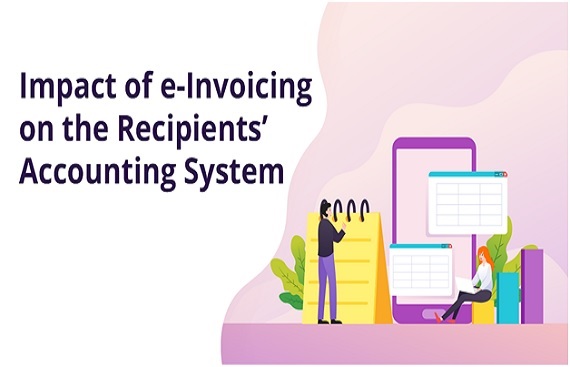Will the Recipient's Accounting System feel the impact of e-Invoicing and IRN?

e-Invoicing under GST has been implemented on large enterprises that have an annual aggregated turnover of INR 500 Crores and more, back in October 2020.
As per the Government Notifications e-Invoicing will soon apply to all the businesses by April 2020.
This being said, Businesses need to understand all the aspects and even the most minor details of e-Invoicing.
It may only apply to large enterprises for now but e-Invoicing will surely have a drastic impact on the recipients of the supplies and the e-Invoices as well, even though they are not directly liable to it.
In this blog we have broken down the impact of e-Invoicing on the recipients of the supply, which makes this blog useful for not only large but small and medium enterprises as well.
Also, towards the end we will share our insights on the best eInvoice software that there is.
Introduction to e-Invoicing from the Recipient’s perspective
e-Invoicing or electronic invoicing is a new process under Rule 48 of the CGST Act 2017, which states that the businesses having an annual aggregated turnover of INR 500 Crores and more will be liable to generating invoices in a specified format and report them on the unified Invoice Registration Portal to obtain IRN and QR Code for the invoices.
This means that businesses must follow the e-Invoice SCHEMA while generating an e-Invoice (Within their ERP/ Billing Systems) and then upload the e-Invoices to the IRP.
The IRP will validate the e-Invoice for errors and duplications and then save the e-Invoice data in IRP.
Upon successful validation the IRP will generate an IRN and QR Code which will be unique for the e-Invoice and will be the identity of the e-Invoice.
This is the e-Invoice generation process. Post this, the next step is that the IRP shares the e-Invoice data with the GST and e-Way Bill Portal for the auto-population of the e-Invoice data in the GST Returns and for generating e-Way Bills wherever required.
Additionally, the IRP also mails the e-Invoice in real-time with the recipient of the supply and the e-Invoice.
As per the Government this will help the recipients as the e-Invoice data will reach the recipient in real-time and without fail and the same will also auto-populate in their GST Returns.
In simpler words recipients will not have to account for the e-Invoice transactions in their GST Returns as the data will auto-populate from the IRP, the recipients can simply declare the other transactions if they have any, file their returns and release the taxes.
This will simplify the work for the recipient businesses up to a large extent.
The Generic yet Significant Impact of IRN on Businesses
![]()
e-Invoicing has already brought many changes to the working of GST as a whole. It has made the process easier and cleaner in the tax evasion context.
e-Invoicingand IRN Generation has drastic impact on businesses, let’s have a look at what these are-
- Time Saver- e-Invoicing is a big time saver for business accountants considering its contributing in the entire tax accounting process. The data is auto-populated in the most convenient areas in the most convenient manner without having to waste time on manual validation and sharing.
- Ensures Accuracy in Tax Accounting- The IRP has a very strict and specific validation criteria which ensures accuracy in the process without having to invest much time and effort.
- Minimum Effort required in the overall compliance process- although businesses will have to comply with e-Invoices and the same as an addition to the compliance load as it is a whole new mandatory process, it has surely reduced the overall GST compliance load by lifting the same from multiple aspects such as e-Way Bills, GSTR Filings, Vendor Compliance, Cash-flow and more.
- Electronic and Automated- The process is automated which makes it efficient in saving time and efforts additionally the fact that it is also paperless will help in saving the environment considering that corporate paper work consumes more trees for paper than anything else.
- Eases the work- e-Invoicing will ease the overall work for the Tax Accountants while ensuring accuracy and in less time.
- Increases the transparency thus keeping the process clean- e-Invoicing has the basic agenda of eliminating tax evasion from the system and it is safe to say that the same is serving its purpose well by now. E-Invoicing has increased the transparency and the involvement of the Government deeper into business transactions making the process cleaner.
- Data Transfer-The IRP will share the e-Invoice data with the e-Way Bill & GST Portal as well as with the recipient of the e-Invoice, this is a very convenient move for both the suppliers & the recipients of the supply.
Effects of e-Invoicing and IRN on Recipient’s Accounting and Billing System
![]()
Now that you know the generic & essential details about einvoice under gst here is everything you need to know about e-Invoicing as a recipient of supplies & how it will impact you and your business.
If you are dealing with large Vendors that are liable to e-Invoicing you need to know these essential details if you don’t already.
Here are a few points to note while dealing with e-Invoice liable Suppliers-
- Identifying the Suppliers- Recipients’ first & most important task is to identify their suppliers that are liable to e-Invoicing. As per Rule 48, all businesses having an annual aggregated turnover of INR 500 Crores & more, are liable to e-Invoicing (Except the exceptional class specified by the Government). Additionally, you can check for the enablement of e-Invoices on businesses via the einvoice Portal. This is important to track if the invoices are e-Invoice compliant or not as the contrary can cause blunder for the recipient as well. Here is a list of businesses that are exempted from e-Invoicing-
- SEZ Units & Developers
- Insurance companies
- Banking Companies
- Financial institutes
- Passenger transportation service, etc.
- Identifying the Liable Documents & supply types- Here is a list of documents & types of supplies liable to e-Invoices-
- Credit Notes
- Debit Notes
- RCM Invoices
- Export Invoices
- SEZ & Deemed Export Invoices
- B2B Invoices
- B2G Invoices
- GST Return Filing & Tax Payment-As per the Government, the e-Invoice data will auto-populate the GST Returns of the small businesses that deal with large enterprises liable to e-Invoices. The recipients will only have to pay the tax liabilities for such transactions. This will help the recipients up to a large extent & save them the effort of filing the taxes manually.
- Cross Verification of the IRN- You can check the authenticity of an IRN by uploading the e-Invoice or the IRN to the NIC or scanning the QR code using the e-Invoice mobile app. either ways, there is no automatic process to tell if IRNs are authentic.
- Editing & Canceling an e-Invoice- You cannot cancel an e-Invoice or an IRN as a recipient, you must contact the supplier to cancel the e-Invoice & within 24 hours of generation. There is no provision to edit e-Invoices as of now, in case you cross the 24 hour limit, you will have to ask the suppliers to generate Debit Notes against the e-Invoice that you wish to cancel.
- IRN & QR Code Relation-The IRN is connected with the QR Code as the QR code will contain the IRN & e-Invoice details. Recipients can simply scan the QR Code & the entire e-Invoice detail will be accounted in their system. The Invoice must however contain both to be valid as per the e-Invoice regulations. The QR Code can be scanned to pay as well if the supplier choses to add a payment link in the QR Code.
- Involvement of e-Commerce Operators in e-Invoice Transactions- e-commerce operators can generate e-Invoices on behalf of the supplier using the supplier’s GSTIN for the recipient. If you purchase from an e-Commerce Operator & not the supplier directly, then the e-Commerce Operators’ turnover will determine whether he is liable to e-Invoices or not.
- Receiving the e-Invoice over official mail- The IRP will share the e-Invoice with the recipient if their mail id is linked with their GSTIN. This is also a proof of authenticity of the e-Invoice & the IRN. The sharing of e-Invoicing over mail in real time will not only help the supplier of the goods but will also impact the recipient of the e-Invoice. The recipients will have the e-Invoice data intact & the same will not be misplaced or go missing in the GST returns.
- E-Invoices without IRN but contains QR Code- Technically it is not suggested that e-Invoices be generated with QR Codes but lack the IRN. However there is no mandate on the same, if the QR Code contains the IRN & e-Invoice details then there may not be the need for having an IRN. Again, the same is not recommended & such invoices need to be verified thoroughly.
- GSTReturn Auto-population- The GST Returns will be auto-populated based on the e-Invoice data that the IRP will share with the GST Portal. This will ease the work for tax accountants as the auto-generated data will be accurate & will not require any extra efforts. As a recipient you can be assured that your GSTR-2A & GSTR-2 will be accurate since the supplier’s GSTR-1 will be auto-populated from the e-Invoice data.
- Impact on Reconciliation- With an accurate GSTR-2A filing, the reconciliation will be simple & direct since the data is fetched from a trusted source-IRP. The reconciliation will be highly accurate & may require less time & efforts.
- Gain more ITC with e-Invoicing- Owing to the fact that e-Invoicing will impact GST Return Filing, & Reconciliation, the same will also impact the ITC claim of the recipient for the better. Recipients will be able to claim maximum & accurate ITC as the suppliers outward supply return will be accurately filed eliminating the chances of discrepancies.
Conclusion
![]()
e-Invoicing has more perks to it than cons both for the suppliers and the recipients, but it is also an addition in the GST Compliance list for businesses.
However, e-Invoicing compliance is of high priority for all businesses that are liable to it irrespective of its impact as it is a mandatory rule under the CGST Act 2017.
The compliance can sometimes be a littlemore difficult than it seems considering the complex SCHEMA Format, Real-time Validations, Bulk operations, Archivingand more.
The Government also recommends the use of external solutions such as GSPs to comply better with e-Invoicing, one such GSP is GSTHero which is also the best e-Invoicing Solution in the market currently.
GSTHero makes e-Invoicing simple to understand and operate with its user-friendly features and prominent support.
So why GSTHero?
- Simple ERP integration
- High Data Security
- Storage- e-Invoice Archiving for 8 years!
- Direct integration of ERP with the IRP
- Scalable for high data volume
- Super Automated- requires minimal human input
- Reduced Errors with automation
- Saves time and delivers prompt results
- Enhanced productivity of your accounts team
- Compliance in real-time
- Bulk Operations- Generate, cancel, print, validate and edit e-Invoice in bulk within the ERP
- Achieve 100% Compliance with e-Invoicing
- Cost-effective
Read More News :
How Would the Venture of Fintech Disrupt Mutual Fund Businesses

